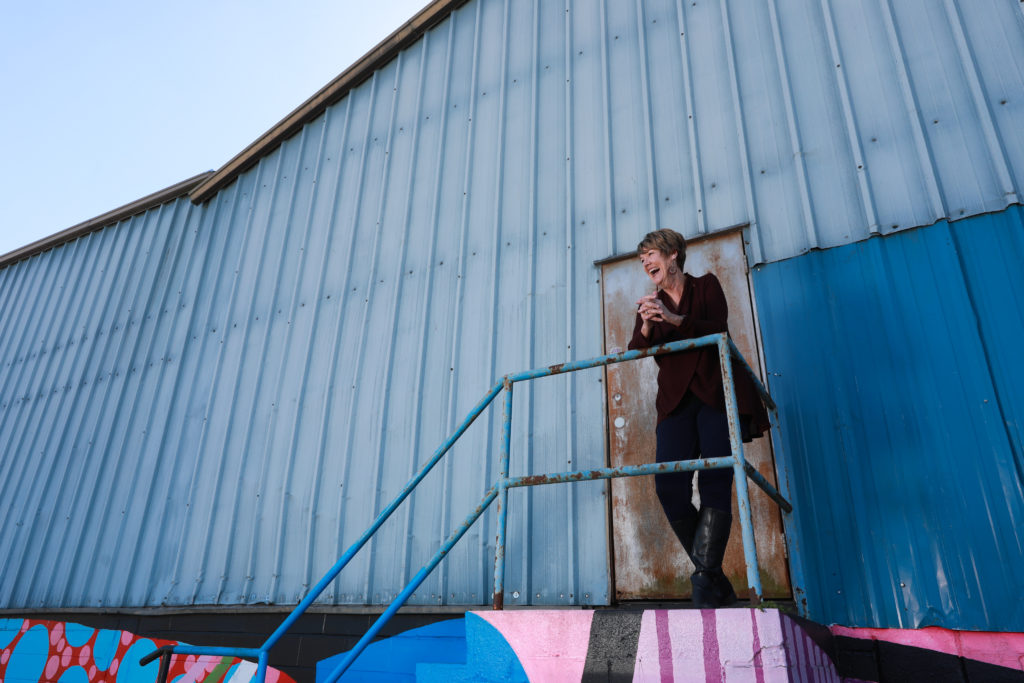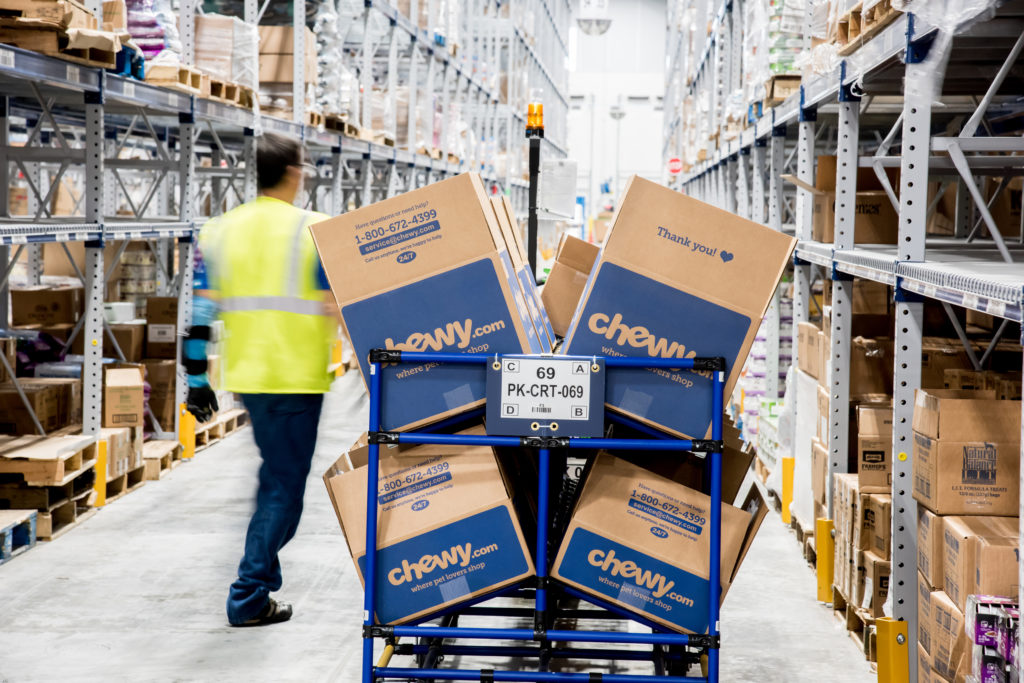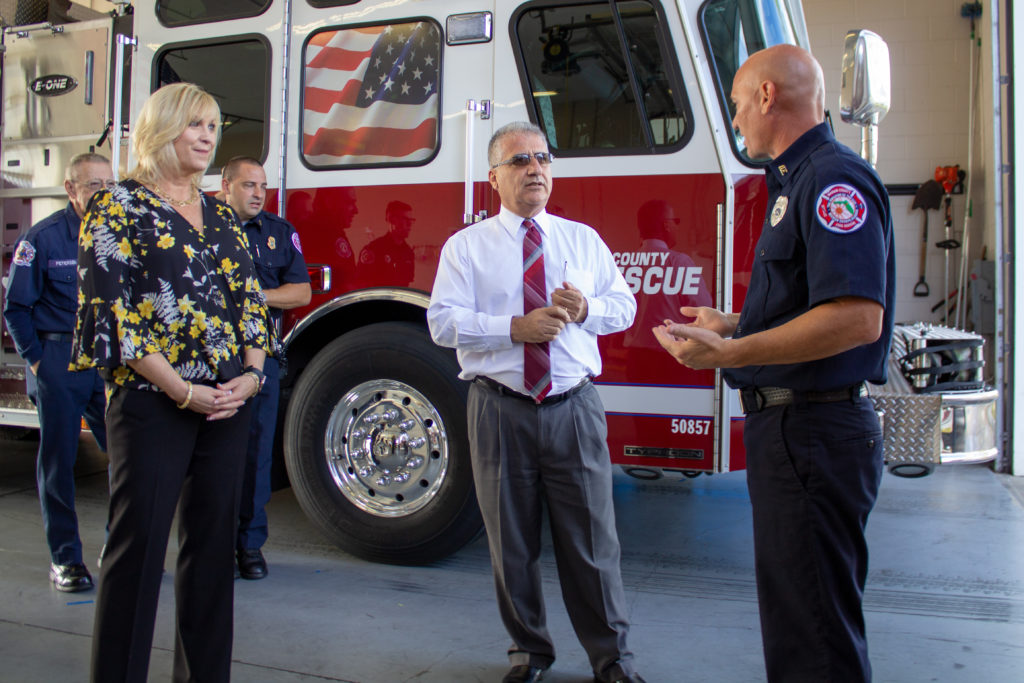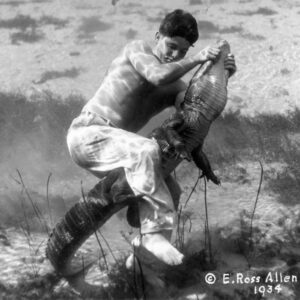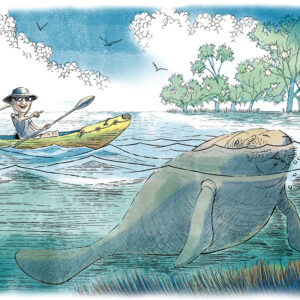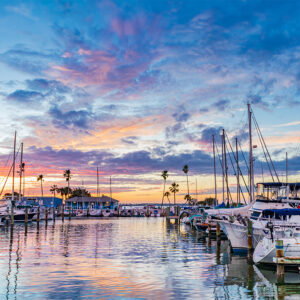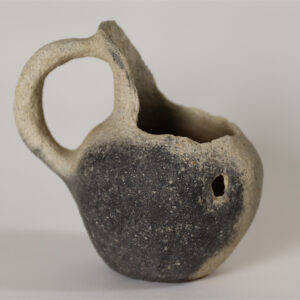With 2018 coming to a close, we at Ocala Style have enjoyed reminiscing about some of the happenings that shaped our community.
We’d like to salute all the community activists that stepped up to the plate and fought hard against the coastal connector project, a substantial threat that would have irreversibly harmed our economy and our way of life. Overcoming this threat, in our opinion, was just as important as all the significant growth you will read about in the following pages. In this story, Ocala Style invited four key players in our community’s past and future to share some of the events and news that made this year prosperous.
The Non-Profit Arts Community
By Jaye Baillie, APR, executive director, Marion Cultural Alliance
The state of the local arts economy is strong, vibrant and growing. We have a city that understands the important role the arts play not only in our quality of life but in attracting companies and a talented workforce that desires to live in a community that values arts and culture. The City’s Arts and Cultural Division, headed by Laura Walker, is a strong partner with Marion Cultural Alliance (MCA) and arts organizations, all working together to grow our arts and cultural assets and programming.
And I’m happy to report the future of the arts in Ocala/Marion County is bright. We now have two studies that show just that.
The City of Ocala, along with its funding partners the Marion Theatre, Appleton Museum of Art, FAFO, Ocala Civic Theatre, Ocala Municipal Arts Commission and Marion Cultural Alliance, participated in the Americans for the Arts fifth study of Arts Prosperity (AEP5). This was the most comprehensive economic impact study of the nonprofit arts and culture industry ever conducted and included 341 cities, counties, states and individual arts districts.
The Americans for the Arts Prosperity 5 (AEP5) study reveals that our nonprofit arts and cultural organizations are economic drivers, creating an industry that supports jobs, generates government revenue and is a growing asset in our tourism portfolio.
AEP5 indicated that our local arts industry has a $56 million annual impact on our local economy, employs 1,429 people and generates $6.1 million in local and state government revenue. The research revealed that for every dollar an arts organization spent, an additional $3 was spent by arts event attendees, not counting the cost of admission.
The second study—by New York based Martinez + Johnson Architecture with Webb Management Services, commissioned by the City of Ocala and partially funded by MCA and the National Endowment—provides strategies to grow opportunities, assets and access to the arts. The final report includes an assessment of our current cultural resources and an evaluation and recognition of progress made to date and provides recommendations in several arts and cultural areas, including the feasibility of a cultural arts district, a marketing plan and an economically viable funding policy.
This cultural road map will lead us to our aspirational goal of being one of the best cities for the arts.
I also see, as the third leg of this ‘cultural stool,’ the five-year strategic plan that Marion County’s Tourism Development Council is developing with their agency, Paradise. After gathering input from cultural groups during a two-day workshop held in late summer, it’s highly likely that marketing for arts and cultural events will be a part of the new, diversified strategy to attract tourists. Other communities have discovered the economic value of attracting the art tourist, as this type of tourist is known to spend more and stay longer in our hotels.
Here’s another reason why I think the state of the arts is strong in our community. Voters were recently asked to renew the referendum that provided much needed funding for initiatives, including art and music instruction in our public schools. Seventy-three percent voted in favor of the 1 mil ad valorem tax projected to raise $17 million per year. A portion of the funding will provide 50 minutes of art and music once a week at the elementary level and a variety of visual art and music classes at middle schools.
Additionally, the district has identified three elementary and three middle school STEAM (science, technology, engineering, arts and math) schools. Here’s an interesting fact: Nobel laureates in the sciences are 17 times more likely to be engaged in the arts than other scientists.
Students who have arts-rich experiences in school do better across the board academically and also become more active and engaged citizens, by voting, volunteering and generally participating at higher rates than their peers.
Just look around and you can see why I’m excited about the expanding landscape of the arts. Public art is now ubiquitous. Ocala’s first public art project produced by MCA and local artists dotted our community with life-size horse statutes. The public responded enthusiastically to their first experience with public, accessible art, and through the sale of the painted horses, MCA established an endowment to ensure arts funding in perpetuity.
Now more than 56 outdoor art objects can be enjoyed. There’s a giant tennis ball at the Fort King Tennis Center, the sculpture stroll in the Art Park and in Tuscawilla Park, the 3-D LED globe on the Discovery Center, murals, art panels at Legacy Park and plans for art installations along Osceola Trail. Seven Horse Fever statues are enjoyed by locals and visitors.
The City and its partner arts organizations have breathed life into historic buildings, including Brick City Center of the Arts, the Reilly Arts Center, the Discovery Center and the Train Depot, creating vibrant spaces for arts, music and science. For the past two years, the City and MCA partnered to host the Levitt AMP Ocala Music Series, a 10-week free concert series located at historic Webb Field.
The Appleton Museum of Art and the Ocala Civic Theatre are longstanding cultural assets—both nationally recognized for excellence and quality and both treasures rarely found in a community our size.
Since 2001, MCA has granted $310,000 in cultural grants to local arts organizations. Our latest initiative, the Four Friends Fund, will provide small grants to artists. We work with arts organizations providing strategies and opportunities to impact the arts and advocate to increase support for the arts. We are honored to be our community’s arts nonprofit catalyst and advocate for cultural impact.
For more information about MCA or to join us in our efforts to support the arts, contact (352)369-1500 or visit mcaocala.com.
The CEP
By Kevin Sheilley, president & CEO, Ocala/Marion County Chamber & Economic Partnership
Covering all the growth in the Ocala Metro is, well, impossible. There are so many incredible things happening in this community that even at the CEP we cannot keep up! The following is a description of some of the growth that is occurring in five key areas: logistics, manufacturing, tourism, retail and wages/population. These are not the only areas growing (RealTruck’s corporate expansion, homebuilding, the boom in health care, etc.), but these five areas are all key drivers in the local economy.
Logistics
The Ocala area is developing a national reputation as a center for logistics. Early 2018 saw the massive new distribution centers for Chewy and AutoZone, both open in the Ocala/Marion County Commerce Park. These facilities already employ more than 300 and 700 people respectively and are continuing to grow into the new year. Also, early in the year, it was announced that McLane Company, a subsidiary of Berkshire Hathaway, was purchasing an existing 113,000-square-foot facility in the Ocala International Commerce Park and would be expanding it to nearly 400,000 square feet. The construction is wrapping up as we end the year, and the company is beginning to hire the first of what will be 500 employees.
Manufacturing
Manufacturing continues to be a significant part of the local economy. Throughout the year, the Ocala MSA was in the top three of Florida metros in manufacturing job growth nearly every month. Although a number of companies expanded throughout the year and added jobs, the new facility for Cardinal LG was the most significant. The national company has had an Ocala facility for 10 years and now employs nearly 600 people. They began construction this year on a second Ocala facility across the street from their current facility. This new 350,000-square-foot facility will be open in mid-2019. Additionally, Cardinal recently announced plans to locate an R&D facility in Ocala to support the laminated glass division.
Tourism
Although tourists visit our community for a variety of reasons (youth sports, ecotourism, the arts), the importance of being the Horse Capital of the World cannot be overstated. A report commissioned by the CEP a few years ago found that the equine industry contributed approximately $2.6 billion a year to the local economy. This amount is sure to only increase when the now-under-construction World Equestrian Center opens in late 2019. This incredible complex will include more than half a million square feet of air-conditioned arena space, a 3-acre Grand Outdoor Stadium, 17 outdoor arenas, 1,500 permanent climate-controlled stalls and a 400-room luxury hotel just to name a few of the highlights. It will truly be a world-class facility unlike any other.
Retail
Retail growth remains strong throughout the community with the area’s two primary retail centers continuing to do well. Paddock Mall continues to boast incredibly low vacancy rates and to welcome new retailers. The mall has begun making significant investments in facility and site upgrades, including the addition of a free-standing Texas Roadhouse, which will begin construction during the late first quarter of 2019. Though the Sears location will be closing, the activity in this market should drive redevelopment of that site relatively quickly.
Market Street at Heath Brook continues its rebirth from bankruptcy to what should be 90+ percent occupancy by the end of the year. This lifestyle center has welcome several new tenants, and a new 12-screen cinema is now under construction. Lastly, the continued growth and redevelopment of downtown continues to build steam. Several new restaurants have opened downtown, including Ivy on the Square, the Lodge and Sayulita as well as retailers Agapanthus and The Pink Hanger. Construction has begun on the new Hilton Garden Inn, and several additional restaurants, stores and townhomes should begin popping up in 2019.
Wages/Population
The Ocala MSA continues to grow. The latest numbers show that last year our community added on net 120 people a week. This continued growth is fueling residential construction and prices. Additionally, not only did we add residents, but we grew the workforce. Private, non-farm payrolls (one of our favorite stats at the CEP) grew by 3 percent this past year and showed signs of continuing to accelerate. Growing the population and workforce is good for all us. It played a part in the growth of two important income statistics.
First, the Census Bureau reported that the median household income in Marion County ballooned an incredible 11.5 percent over the past year. This rate was nearly 10 times the national growth. Finally, the average weekly wage (another CEP favorite) has grown by 14.8 percent over the last five years. Again, this growth dwarfed the state and national rates over this period.
The year 2018 will go down as a great year for growth all across this community. However, this is not the end. All of these sectors along with health care, homebuilding and others are primed for continued growth through the end of the decade. There may have never been a better time to call Ocala home!
Learn more at ocalacep.com
The County
Mounir Bouyounes, county administrator, Marion County, Florida
With 2018 drawing to a close, it’s a great time to reflect on this unforgettable year. I am immensely proud of the work our organization is doing to make Marion County the best place in Florida to live, work and play.
Part of what makes Marion County so great is the generosity of our county employees. We had a record year in both the annual Stuff the Bus campaign, with 18,000 items collected, and the Bring the Harvest Home holiday food drive, which netted more than 20,000 pounds of food and toiletries. Helping our community is an excellent example of the shared values all Marion County employees hold dear, but the help we offered our community over the past year is just the tip of the iceberg when it comes to county accomplishments.
The efforts we are undertaking today will define the character of our community for many years to come. Below are highlights of some of the great things we have accomplished in the past year.
Recruitment, Retention & Reorganization
Marion County’s economy is booming, which means that the local government must remain creative to attract and retain the best employees. This year, we made great strides by adjusting pay and reorganizing specific departments, including Fire Rescue, Information Technology and Building Safety.
Fire Rescue has struggled over the past few years to remain competitive, with many recruits being trained, gaining experience and then leaving for higher wages. The County Commission held an extensive workshop with the Fire Chief in March, resulting in contract negotiations that led to pay raises, enabling us to retain our current paramedics and attract new ones. As of October 1, all Marion County paramedics are paid a minimum starting wage of more than $50,000.
Information technology is a fast-growing career field, meaning hiring is competitive. The county’s technology infrastructure is integral to our organization’s ability to provide excellent customer service. Over the last few years, numerous IT employees have been lured away with higher salaries. This year, our organization undertook an extensive salary study and has instituted pay adjustments aimed at retaining these key personnel.
A third area we placed emphasis on this year is our Building Safety department. During the recession this department, which is wholly supported by the revenue it generates, was forced to reduce staff. Fortunately, the local economy picked up steam and building commenced. However, the staffing levels remained low. In response, staffing levels were addressed and the department was restructured, resulting in inspections occurring within one business day of a request. There have been many comments from industry professionals that our department now processes permits faster than anyone else in Central Florida.
The costs of the amended fire rescue contract, departmental pay adjustments and reorganization are being funded by the existing fire assessment, building department revenue and increased general fund revenue. This is a huge win for Marion County, and I’m really excited that we were able to make great strides in these areas.
Penny Sales Tax
The Penny Sales tax has yielded great results this year and has allowed the county to continue completing important infrastructure and capital projects. This supplemental income allows the county to tackle necessary projects for our community’s safety and comfort, without compromises.
It’s only one penny out of (almost) every dollar spent in Marion County, but the funds collected through the first two years of the county’s penny sales tax resulted in many projects being completed and many others commencing.
Roads are being paved all over the county, with nearly 15 miles completed and another 44 miles in progress. Fire Rescue has received new ambulances, fire trucks and essential safety equipment, among other items. The Sheriff’s Office has been able to purchase a new helicopter, safety vests and more than 100 patrol vehicles. Another major project that positively impacts all public safety personnel is the purchase and distribution of 2,000 new radios, ensuring the ability of first responders to communicate as they serve our community.
With an estimated 30 percent of the tax paid by tourists and travelers, this funding is essential to our community growing in a smart way. If you would like more information on the penny sales tax, visit marionsalestax.org.
Budgeting Wisely
Marion County has long focused on living within our means while continuing to provide first-class services to the public. This year was no different, as we focused on maintaining the countywide millage rate while tackling key objectives.
Our goal was accomplished, as the county’s general fund budget did not result in any property tax increases. The general fund millage rate remains at 3.33 mills for the new fiscal year.
Maintaining the millage rate is a big accomplishment, especially when portions of the aforementioned salary adjustments are included as components of the general fund budget. Another major project was also funded, as the second year of the Enterprise Resource Planning software implementation received $1.7 million. The ERP will revolutionize the way county departments do business, even creating a customer service portal for citizens to utilize.
Exploring Our Recreational Future
Recreational opportunities are very important to visitors and residents alike, and Marion County is continually focused on improving future recreational opportunities.
Our community has long had a need for a major facility to host conventions, graduations and indoor sports tournaments, so the county undertook an extensive study to explore our community’s needs and what kind of facility we are capable of supporting. A list of potential sites was generated, and the county is currently exploring the development of a facility adjacent to the World Equestrian Center development.
Many folks have heard about the pool closing soon at the College of Central Florida, resulting in no venues to host swim competitions. Well, the county completed a study on the potential of establishing an aquatic facility, which would include both competitive swimming pools and a water park. This should be a self-sustaining facility, and we anticipate having more information in the coming months.
Marion County’s parks are some of the best in the state, offering natural greenspace, paved trails and sports parks. The Parks and Recreation department completed a comprehensive master plan, which highlights areas for expansion and improvement as we strive to meet the needs of residents and visitors.
These future projects are exciting and something to keep an eye on as our community continues growing.
A New Visitors’ Center Provides Promotion & Community Safety
This year also marked a big move for the county’s Tourist Development team. The department’s visitors’ center was previously located a couple of blocks off of Silver Springs Boulevard in downtown Ocala. An opportunity presented itself to acquire the old Wells Fargo building, right in the thick of downtown’s main roadway, and the county completed a land swap to gain this ideal location.
Visitors are now greeted by a larger, more inviting welcome center right on Silver Springs Boulevard, giving our tourist development team an ideal location to promote Marion County’s wide array of activities.
The new facility is also home to the Guardian ad Litem program, which provides advocates for Florida’s most vulnerable children.
In addition, the facility provides key public safety redundancy, as the ground level will serve as a backup center for the county’s emergency operations center and 911 call center. Part of this project will also be funded by the penny sales tax.
We’re excited about all that the future holds for Marion County.
For more information on these and other county topics, visit marioncountyfl.org.
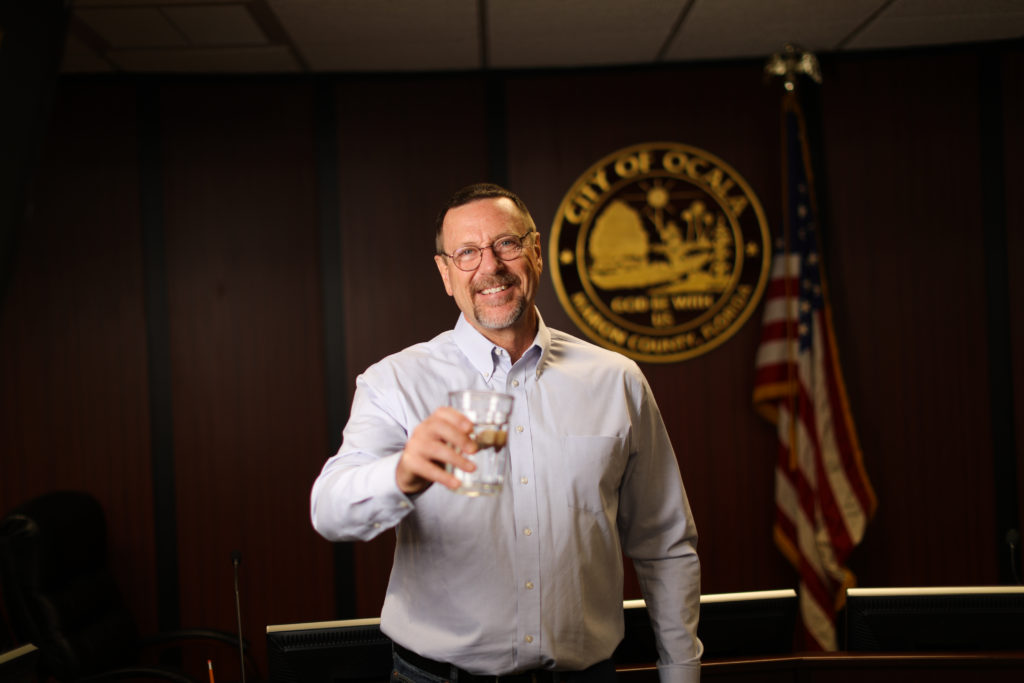 The City
The City
John Zobler, city manager, City of Ocala, Florida
“The secret to life is not getting what you want but wanting what you got.” The City of Ocala has got a lot. We devote much forward-looking energies to nourishing continued population growth, superior employment opportunities and improved quality of life. However, great care must be taken now to protect and restore the many valuable resources we already have. Through your support, the city can focus on its stewardship responsibilities to ensure that the resources needed today are available for our generations of tomorrow.
Reinvestment Projects Funded By The Penny Sales Tax
Since its approval by Marion County and City of Ocala voters in 2016, the revenue generated by the penny sales tax has allowed the City of Ocala to improve its public safety and transportation infrastructure. To date, city purchases funded by the penny sales tax include new vehicles and communication equipment for the Ocala Police Department, two new fire stations and one new Police District Substation, as well as miles of road resurfacing and thousands of feet of sidewalk improvements. More than $9.2 million in penny sales tax dollars have been invested back into your City’s infrastructure, as promised.
First Responder Campus: Fire Station No. 1/Ocala Police Department
In December 2018, Fire Station No.1 will relocate from its current site near Tuscawilla Park to the new First Responder Campus located at 340 NE Eighth Avenue. This campus will also include a new home for the District No.2 office for the Ocala Police Department.
Fire Station No. 7
The City of Ocala celebrated the grand opening of Fire Station No. 7 in June 2018. The station, located at 885 SE 31st Street, is the city’s first new fire station expansion in nearly a decade. Station No. 7 is now home to Ocala Fire Rescue’s Special Operations unit and will also help improve response times in the southeast and south-central areas of the city limits.
The estimated cost for the First Responder Campus and Fire Station No. 7 is approximately $5 million.
Revitalization Royal Oak
During the Ocala Vision 2035 process, completed in 2012, the Royal Oak site and surrounding area was identified by residents as suitable for medium intensity residential and commercial development. For decades prior, the Royal Oak charcoal manufacturing plant, located at 1921 NW 17th Place, spewed soot, ash and other contaminants into the environment with heavy concentrations affecting many nearby areas. In 2006, after a years-long grassroots effort led by Mrs. Ruth Reed, the Florida Department of Environmental Protection (FDEP) found contaminants exceeding acceptable levels and shut down the operation. After minor demolition removed the smoke stacks and several buildings, the property was fenced off and abandoned. Ten years later, Royal Oak sold the property to an investor.
Over the past decade, the City of Ocala made several unsuccessful offers to purchase the property for redevelopment to improve the northwest part of the city for its citizens. The investor was eventually willing to sell the property, and with the financial assistance from FDEP to perform the environmental assessments, the city purchased the site in April 2018. Some soil contamination was found and is in now in a remediation phase. Right now, the existing buildings, concrete and asphalt are being demolished to prepare the site for redevelopment.
Because of its proximity to the Ocala/Marion County Commerce Park where FedEx, AutoZone and Chewy now operate with roadway access, existing neighborhoods and public facilities, the Royal Oak site is ideal for construction of additional housing, retail and recreation facilities. Combined with the new Wetland Groundwater Recharge Park, set to open in late 2019, and redevelopment of the Pine Oaks Golf Course, this area promises to be a vibrant center that will benefit the entire city.
Environmental Protection Wetland Groundwater Recharge Park
The Wetland Groundwater Recharge Park is an important part of the City of Ocala’s plan to conserve its natural resources. This new nature and conservation park is a city-owned, 60-acre parcel adjacent to the Pine Oaks Golf Course. The park will conserve existing oak trees, convert current ponds to deep marshes and fairways to wetlands. Additionally, development of this park will create wetland habitats, improve water quality and boost regional groundwater supplies. The park will be home to a vast number and variety of plants and wildlife. A very extensive walking trail system, pavilion seating and viewing areas and a conservation education center are key components that will be constructed to complete this important conservation project.
The City, and many others, rely on the Upper Floridan Aquifer for water. Recharge is the water that drains through the soil to refill the groundwater and supplies the aquifer underneath. This aquifer also provides flow to the Silver Springs system. The city’s forward-thinking strategy is to address both issues by creating a system that improves water quality, purifies water that feeds into the Silver River and increase precious groundwater supplies.
The City of Ocala consumes an average of 12 million gallons of water per day. The Wetland Park will be able to recharge up to 5 million gallons of storm water and treated waste water per day.
Approximately half of the funding for this project was made possible by the Florida Department of Environmental Protection and the St. Johns River Water Management District. The approximate cost of this project is $8 million.
This park, which broke ground in the summer of 2018, is expected to open to the public in late 2019.
Learn more about city happenings at ocalafl.org.

